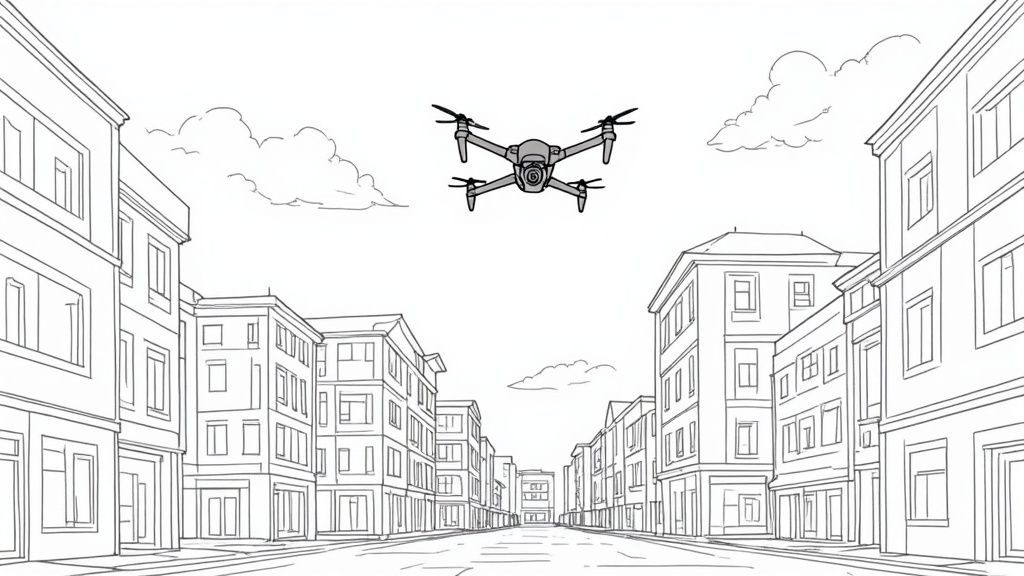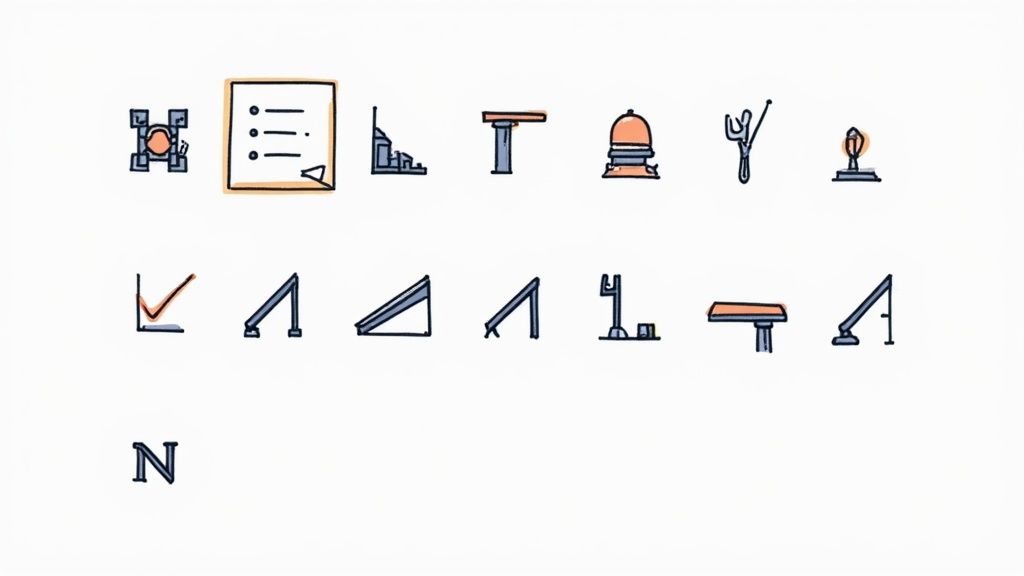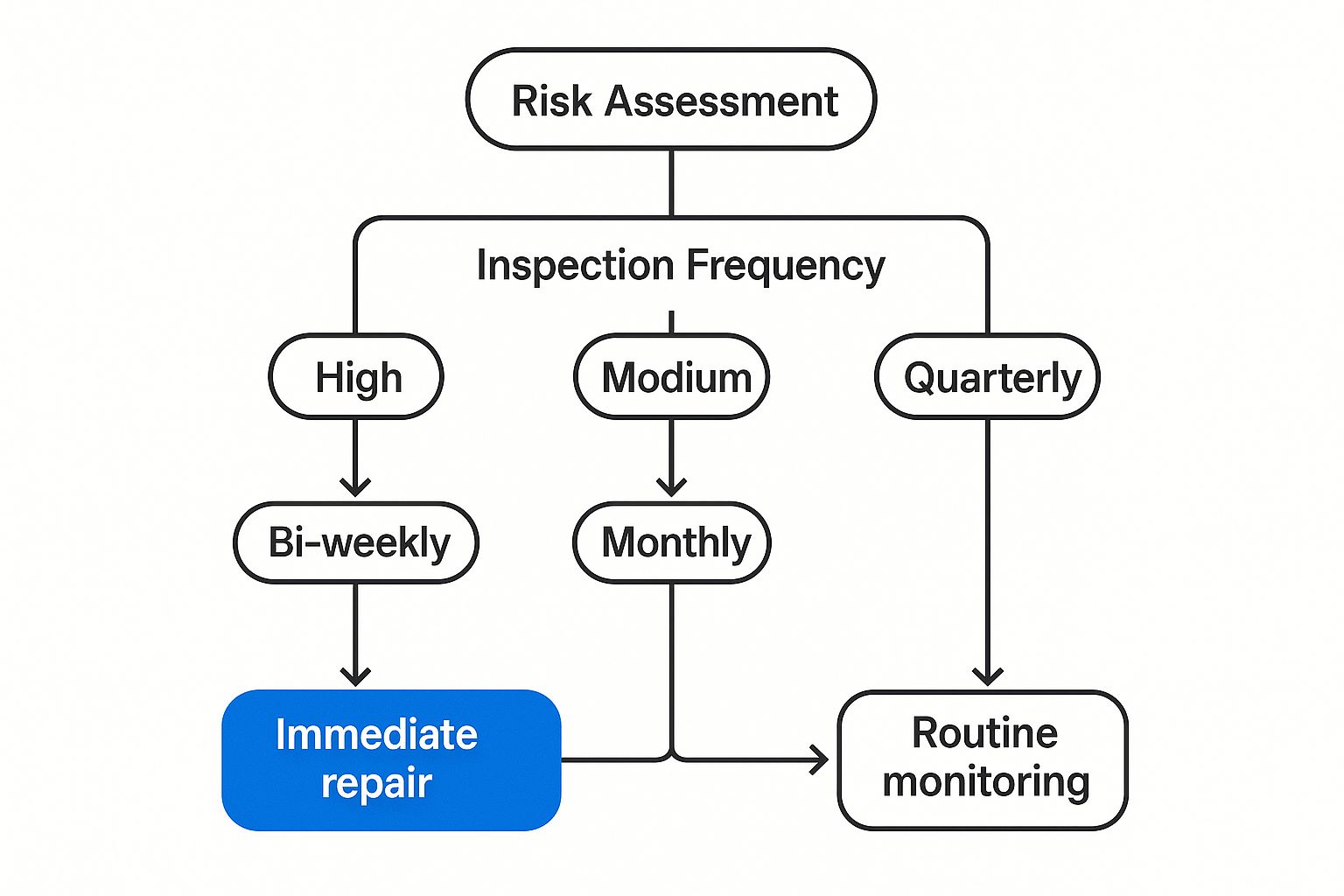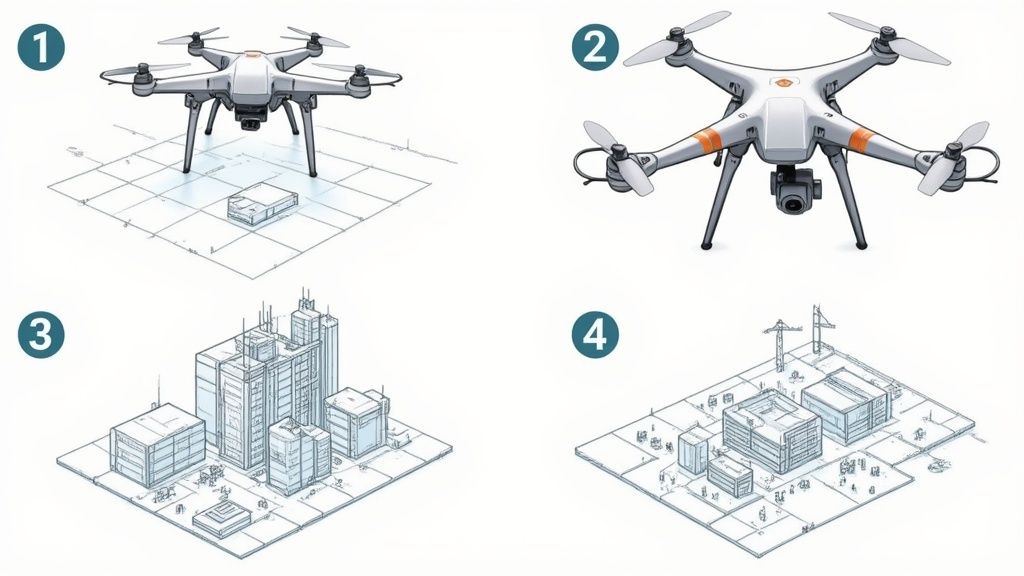Construction Drone Inspection: Essential Guide for Builders
- Paul Simmons
- Jun 2
- 13 min read
Updated: Jun 4
Understanding Modern Construction Drone Inspection Technology

Construction drone inspection is changing how we assess and manage sites. It offers a safer, faster, and more detailed approach than traditional methods, allowing for inspection of previously inaccessible areas. This leads to more comprehensive evaluations and is driving significant industry growth.
The global construction drone market is expected to hit USD 21,806.6 million by 2033. That’s a 13.4% CAGR from its USD 7,023 million valuation in 2024. This expansion is driven by the increasing demand for drones equipped with advanced sensors for site surveying, progress tracking, and in-depth inspections. Find more detailed statistics here
Key Technologies Powering Drone Inspections
Several key technologies make construction drone inspections effective. These tools provide valuable data and insights for construction professionals.
LiDAR (Light Detection and Ranging) lets drones create accurate 3D models of structures and terrain. This data is crucial for accurate measurements and analysis.
Thermal imaging detects temperature variations, revealing hidden problems like moisture damage and electrical faults. These insights are critical for preventative maintenance and hazard identification.
Ultra-high-resolution cameras capture highly detailed images and videos, documenting a site’s condition and progress.
Professional Vs. Consumer Drones: A Critical Distinction
While consumer drones are readily available, professional-grade drones offer distinct advantages for construction inspections, particularly in data accuracy and reliability.
Flight stability is a key differentiator. Professional drones excel in maintaining stable flights, even in tough conditions, crucial for capturing high-quality data.
Sensor integration is another vital aspect. Professional drones seamlessly integrate with specialized sensors like LiDAR and thermal cameras, capturing data consumer drones cannot.
Software integration is also paramount. Professional drones frequently use sophisticated software to process raw data into actionable insights.
Real-World Applications and Benefits
Drone inspection is useful throughout a construction project's lifecycle.
During planning, drones survey sites and create precise maps, aiding in project design and resource allocation.
During construction, they monitor progress, identify potential delays, and track materials.
During post-construction inspections, drones assess the completed structure, ensuring quality and safety.
These applications lead to tangible benefits for construction companies, such as improved safety, faster inspections, and cost savings. By proactively identifying potential issues, drones help prevent expensive repairs and delays.
Proven Efficiency Gains That Drive Real Results

Integrating drone technology into construction inspections isn't just a passing trend; it signifies a fundamental shift towards improved efficiency and cost savings. This directly strengthens the bottom line for construction firms adopting this technology. But what tangible results can we expect?
Drone-based inspections demonstrably deliver significant gains. For instance, recent data reveals that using drones for inspections increased measurement accuracy by 61% and reduced data collection time by 53% compared to traditional methods. This translates to quicker decisions and considerable savings in time and labor costs. For more detailed statistics, check out this resource: Construction Drone Market Statistics. These advantages empower construction teams to optimize their workflows.
Quantifying the ROI of Drone Inspections
The return on investment (ROI) for construction drone inspections is substantial and measurable across key areas, providing companies with a clear view of the financial benefits.
Reduced Labor Costs: Fewer staff members are needed for inspections, directly saving on salaries and related expenses. This allows for more efficient resource allocation throughout a project.
Faster Project Completion: Quicker inspections accelerate project timelines, enabling companies to undertake more projects and boost revenue. This increased efficiency directly contributes to successful project outcomes.
Minimized Rework: Improved data accuracy reduces errors and rework, preventing costly delays and material waste. Accurate data plays a crucial role in controlling project costs.
Enhanced Safety: Drones access hazardous locations without endangering workers, minimizing workplace accidents and associated costs. This heightened safety fosters a better work environment.
Real-Time Data and Collaborative Decision-Making
Instant data access through drone inspections transforms on-site decision-making, facilitating rapid responses to emerging problems. Project managers, for example, can instantly view high-resolution images and 3D models, enabling remote collaboration with stakeholders and faster problem resolution. This streamlined communication enhances coordination and project management.
AI and Automated Anomaly Detection
Integrating Artificial Intelligence (AI) and machine learning with drone inspections is further transforming how potential issues are identified. AI algorithms analyze gathered data, automatically pinpointing anomalies and potential structural defects that might go unnoticed by human inspectors. This proactive approach enables early intervention, preventing minor problems from escalating into major, expensive issues. This automated analysis significantly improves inspection efficiency and effectiveness.
Case Studies and Industry Adoption
Numerous construction companies are realizing tangible benefits from drone inspections, providing compelling evidence of this technology's effectiveness. For example, one large commercial construction firm reduced inspection time by 75% using drones, freeing up valuable time for other essential tasks. In another case, a small residential builder avoided costly rework by identifying a foundation problem early on thanks to a drone inspection. These success stories are fueling broader adoption of drone inspections as standard practice across projects of all sizes, highlighting the growing importance of drone technology in the construction industry.
Choosing The Right Construction Drone Inspection Type
Picking the right drone inspection for your construction project is essential to getting the most out of this technology. This requires careful planning in each project phase to choose the best fit. Let's explore the different types of drone inspections and when they are most effective.
Common Construction Drone Inspection Types
Structural Integrity Assessments: These inspections use high-resolution cameras, and often LiDAR, to find structural problems like cracks or damage in buildings, bridges, and other infrastructure. These detailed assessments help ensure safety and can prevent expensive repairs down the line.
Progress Monitoring: Drones with high-resolution cameras can efficiently track how a project is progressing. This helps create accurate as-built documentation and identify potential delays. Project managers can use this real-time data to stick to tight schedules and manage resources effectively.
Thermal Inspections: Thermal cameras can detect temperature changes that aren't visible to the naked eye. This helps find hidden moisture, insulation problems, and electrical hot spots. A good example is using thermal imaging to quickly pinpoint roof leaks or poor wall insulation.
Photogrammetry: This technique uses overlapping aerial photos to create precise 3D models. These models are incredibly helpful for accurate measurements, calculating volumes, and detailed site documentation. Photogrammetry is especially good at capturing complex shapes and structures.
LiDAR Scanning: LiDAR uses lasers to create super-accurate 3D point clouds of structures and terrain. This allows for precise measurements and helps with things like estimating material quantities. LiDAR is especially useful in tricky environments or when very detailed surveys are needed.
Matching Inspections to Construction Phases
Different construction phases benefit from particular drone inspection types. In the pre-construction phase, LiDAR and photogrammetry provide accurate site surveys. During active construction, progress monitoring and structural integrity assessments help ensure quality and safety. And in the post-construction phase, thermal inspections can uncover hidden issues before handing the building over.
To help visualize how different risk levels impact inspection frequency and subsequent actions, let's take a look at the following table:
To help illustrate the decision-making process for selecting the appropriate drone inspection type, the table below provides a comparative overview of various methods, their applications, and key advantages.
Construction Drone Inspection Types Comparison
Inspection Type | Primary Sensors | Main Applications | Key Benefits |
|---|---|---|---|
Structural Integrity Assessments | High-Resolution Cameras, LiDAR | Identifying structural weaknesses, cracks, or damage | Ensures safety compliance, prevents costly repairs |
Progress Monitoring | High-Resolution Cameras | Tracking project progress, creating as-built documentation | Identifies potential delays, optimizes resource allocation |
Thermal Inspections | Thermal Cameras | Detecting moisture problems, insulation deficiencies, electrical hot spots | Reveals hidden issues, improves energy efficiency |
Photogrammetry | High-Resolution Cameras | Creating precise 3D models, site documentation | Accurate measurements, volume calculations |
LiDAR Scanning | Lasers | Creating 3D point clouds, precise measurements | Highly accurate surveys, material estimation |
This table provides a clear overview of the various drone inspection methods, their respective applications, and the key benefits they offer. By carefully comparing these options, construction professionals can select the most suitable approach for their specific needs.
Making Informed Decisions

The infographic shows a decision tree for choosing the right drone inspection, starting with assessing the risk (high, medium, or low). This determines how often inspections are needed (bi-weekly, monthly, or quarterly) and the recommended next step (immediate repair or routine monitoring). High-risk areas need more frequent checks and possibly immediate action. Lower-risk areas can be checked less often. This targeted approach ensures resources are used wisely and potential problems are addressed promptly.
Understanding the different types of drone inspections and how they're used helps you make smart decisions and get the best return on your drone technology investment. Choosing the right approach is crucial for a successful project and a safe construction site. This ensures you are gathering the most relevant information for your particular needs.
Smart Implementation Strategies That Actually Work
Integrating drone inspections into construction operations takes more than just buying a drone; it requires a well-thought-out strategy. This means carefully planning how drones fit into existing workflows to truly maximize their potential.
Identifying Key Areas for Drone Integration
Start by identifying specific inspection tasks where drones offer the greatest advantages. Dangerous or hard-to-reach areas, for instance, are perfect for drone inspections. This focused approach helps ensure a measurable and noticeable return on investment. Prioritizing these areas also allows for the efficient allocation of resources.
Look for tasks where drones can significantly enhance data quality or speed up inspections. Roof inspections, for example, benefit greatly from drones. They provide high-resolution images and thermal data much quicker than traditional manual methods. This rapid data collection enables faster decision-making. Finding these opportunities ensures efficient budget use and overall project success.
The construction drone services market is poised for significant growth. Projections show an increase from $1.74 billion in 2025 to $14.28 billion by 2035, with a CAGR of 23.4%. The U.S. is expected to be a key player, growing at a CAGR of 24.6% during this period. You can learn more about this growth here: Construction Drone Services Market Growth. This expanding market reflects the increasing value and adoption of drone technology in construction.
Staff Training and Workflow Integration
Staff training is essential for successful drone implementation. A thorough training program should cover drone operation, data analysis, and all relevant safety regulations. This empowers your team to use the technology safely and effectively.
Workflow integration is equally critical. Rather than treating drone inspection as a separate process, integrate it into existing workflows. This might involve updating data management systems to handle the new information drones provide. This integration maximizes the value of the data collected.
Data Management and Accessibility
Efficient data management is key. Implement systems that allow for simple storage, retrieval, and analysis of drone data. This information needs to be easily accessible to relevant team members, promoting informed decisions and collaboration. A central platform for drone data can significantly improve project coordination and communication. This also ensures data consistency and simplifies analysis.
Overcoming Implementation Challenges and Measuring Success
Expect challenges like weather conditions, data storage capacity, and airspace restrictions. Develop contingency plans to address these potential issues proactively. This minimizes downtime and keeps projects on track.
Finally, set clear metrics to measure your drone program's success. Track key indicators like inspection time, cost savings, and data accuracy. These metrics provide valuable insights into program effectiveness and highlight areas for improvement. Regularly monitoring these factors ensures your drone program aligns with your business goals and delivers the expected ROI.
Service Models That Fit Your Budget and Needs

The construction drone inspection services market offers a variety of options for accessing this valuable technology. This allows companies of all sizes to find a service model that fits their budget and the specific needs of their projects. This flexibility is a major factor contributing to the increasing use of drones in construction.
Drone-as-a-Service: Expanding Access to Technology
The Drone-as-a-Service (DaaS) model is opening up access to sophisticated drone technology. With DaaS, companies can leverage the benefits of construction drone inspection without the large initial investment usually associated with purchasing and maintaining their own equipment. This is particularly attractive for smaller businesses and those with less frequent inspection needs.
Exploring Different Service Models
There are several DaaS models available, each with its own set of pros and cons.
Subscription-based services: These provide regular access to drone inspections for a recurring fee. This predictable cost structure is a good fit for companies with ongoing inspection needs.
Project-specific contracts: These are designed for individual projects, offering customized solutions and pricing tailored to the particular requirements of each project. This model is often beneficial for larger, more complex projects with specialized inspection requirements.
Hybrid models: These typically combine equipment rental with access to expert operators and data analysts. Companies can rent the drones and also utilize the knowledge of experienced professionals. This provides flexibility and cost-effectiveness for companies making the transition to drone inspections.
Evaluating Service Providers and Capabilities
Choosing the right construction drone inspection service provider requires careful evaluation of their capabilities. It's important to consider their experience in the construction industry, the types of drones and sensors they use, and their data processing and analysis capabilities. Examining their safety record and regulatory compliance is also essential. A comprehensive evaluation ensures the chosen provider aligns with the particular demands of your project.
Key Questions to Ask When Comparing Options
Comparing service providers effectively requires asking the right questions. Inquire about their data delivery formats, data security measures, and typical project turnaround times. Understanding these practical details is crucial for a smooth and efficient inspection process. For more information on protecting your investment, check out our guide on drone business insurance.
The Impact of Evolving Regulations
Drone regulations are constantly changing, impacting licensing requirements and operational restrictions. These changes can affect service availability and cost. Staying up-to-date on these regulatory developments is critical for making smart choices regarding your drone inspection strategy.
Specialized Inspection Providers and Credential Assessment
An increasing number of specialized inspection providers are entering the market, bringing expertise in specific areas such as bridge inspections or wind turbine assessments. When evaluating a specialized provider, verifying their credentials is crucial. Look for relevant certifications, industry affiliations, and a demonstrated track record in their chosen area of expertise. This careful review helps ensure you are selecting a qualified and reputable service provider. Choosing the right construction drone inspection service establishes a strong base for accurate data collection and well-informed decisions throughout your projects.
Safety Protocols And Compliance Made Simple
Operating drones safely on construction sites requires a solid understanding of aviation regulations and construction site safety standards. While this might seem like a lot to handle, a systematic approach makes it manageable. This section breaks down the key safety protocols for protecting personnel and equipment during construction drone inspections, offering practical checklists you can implement right away.
Pre-Flight Safety Procedures
Before any drone leaves the ground, certain precautions are essential. A thorough pre-flight checklist is a must. This includes checking the drone's battery life, calibrating the GPS, and making sure all sensors are functioning correctly. It's much like checking your car before a long road trip. Also, visually inspect the drone for any physical damage that could impact its flight. This proactive approach minimizes potential risks and ensures safe operation.
Next, assess the environmental conditions. Wind speed, rain, and visibility are all key factors in safe drone operations. Strong winds can make controlling the drone difficult, while low visibility can cause collisions. Understanding these factors and how they affect drone flight is essential.
Finally, establish a designated take-off and landing zone. This area should be clear of obstacles and people, minimizing the risk of accidents during take-off and landing. A well-defined zone also makes drone operations more efficient. These pre-flight steps create the foundation for a safe and productive inspection.
Navigating Airspace Restrictions and Site Coordination
Construction sites often have unique airspace challenges. Understanding and following airspace restrictions is critical. Use available apps and websites to check for any temporary flight restrictions (TFRs) or no-fly zones in the area. This proactive step prevents conflicts and ensures regulatory compliance. You might find this helpful: Understanding Drone Regulations: A Comprehensive Guide for Every Country.
Coordinating with ongoing site activities is also important. Communicate clearly with all site personnel about planned drone operations. This avoids confusion and ensures everyone is aware of the drone's presence, improving overall site safety. Just like construction crews coordinate their work, integrating drone operations into the site's workflow is crucial for safe and smooth operations.
Regulatory Landscape and Insurance Considerations
Commercial drone operations require adherence to Federal Aviation Administration (FAA) regulations. This includes obtaining the correct certifications and following specific operational guidelines. Staying up-to-date on these regulations is essential for maintaining compliance and safe operation.
Insurance is another vital aspect of professional drone operations. Adequate liability coverage protects your business if accidents or damage occur. This provides financial security and peace of mind. Selecting the right insurance policy specifically for drone operations is a crucial business decision.
Safety Management Systems and Documentation
A robust Safety Management System (SMS) formalizes safety protocols and procedures. An SMS outlines risk assessments, emergency procedures, and maintenance schedules. This structured approach to safety management improves operational safety and reduces the chance of accidents.
Keeping detailed documentation of all drone flights, maintenance records, and pilot training is also key. This documentation creates a valuable record of operations and helps with compliance audits. Thorough record-keeping shows a commitment to safety and professionalism.
Urban Construction Environments: Special Considerations
Urban environments add complexity to construction drone inspections due to limited space and increased pedestrian traffic. These environments require additional safety measures. Establishing clear communication with nearby residents and businesses, for example, minimizes disruption and maintains positive community relationships.
Having strategies for unexpected events like sudden weather changes or equipment malfunctions is vital. This means having backup plans and emergency procedures ready. Being prepared for these scenarios ensures a swift and effective response, increasing safety and minimizing potential damage. Addressing these unique challenges allows construction drone inspections to be conducted safely and efficiently, even in demanding urban environments.
Future-Proofing Your Construction Drone Strategy
The construction drone inspection field is rapidly evolving. Staying competitive requires understanding emerging trends and how they might impact your business. This means keeping an eye on promising technologies and adapting your strategies accordingly.
Emerging Technologies Reshaping Drone Inspections
Several key technologies are poised to transform how we conduct construction drone inspections. These advancements offer exciting possibilities for greater efficiency, improved data, and safer operations.
Enhanced AI for Automated Defect Detection: Artificial intelligence (AI) is becoming increasingly sophisticated in its ability to automatically detect defects in drone imagery. This reduces the time spent on manual reviews and allows for earlier identification of potential issues. For instance, AI algorithms can analyze images to pinpoint cracks in concrete or corrosion on steel structures.
Improved Battery Systems: Advances in battery technology promise significantly longer flight times. This means drones can cover larger areas in a single flight, boosting the efficiency of large-scale inspections. It also opens doors for more complex inspections requiring extended airtime.
Autonomous Drone Systems: Envision drones conducting routine inspections without a pilot. Autonomous systems are under development to achieve this, further automating the inspection process and reducing labor costs. This technology could free up personnel for other tasks and streamline inspection workflows. Check out this interesting article: How to master drone collision avoidance.
Cloud-Based Analytics Platforms: These platforms democratize access to powerful data analysis tools. Even small construction teams can now process and interpret drone data without needing expensive software or specialized in-house expertise.
The following table provides a summary of these emerging trends and their potential impact on construction drone inspections. It outlines the current status of each technology, its expected benefits, and a projected timeline for wider adoption.
Technology | Current Status | Expected Benefits | Timeline |
|---|---|---|---|
Enhanced AI for Automated Defect Detection | Pilot programs, early adoption | Reduced manual review time, earlier problem detection | Next 2-3 years |
Improved Battery Systems | Active development, early testing | Longer flight times, larger coverage areas | Next 1-2 years |
Autonomous Drone Systems | Research and development, limited trials | Fully automated inspections, reduced labor costs | Next 5-7 years |
Cloud-Based Analytics Platforms | Increasingly available and affordable | Accessible data analysis tools, improved collaboration | Now and ongoing |
As this table shows, the future of drone inspection is bright, with advancements poised to significantly improve efficiency and effectiveness.
Data Integration and Real-Time Collaboration
Data integration is becoming increasingly vital in construction drone inspection. Linking drone data with Building Information Modeling (BIM) systems creates a powerful synergy. This allows construction teams to compare as-built conditions with the original design, quickly identifying discrepancies and potential problems. Furthermore, real-time collaboration tools are transforming how inspection results are shared and utilized. These tools allow both field teams and office personnel to access and discuss data instantly, leading to faster decision-making.
Preparing Your Organization for the Future of Drone Inspection
Preparing for these advancements involves staying informed about new technologies. Assess your organization's current capabilities and pinpoint areas where new technologies could provide the most significant benefits. However, avoid overcommitting to unproven solutions. Start with pilot programs and thoroughly evaluate results before making large investments. Focus on building a flexible drone strategy that can readily adapt to the evolving technological landscape. This will ensure your organization remains competitive and benefits from advancements in construction drone inspection.
Ready to take your construction projects to new heights with drone technology? Visit JAB Drone today to learn more about the latest advancements.



